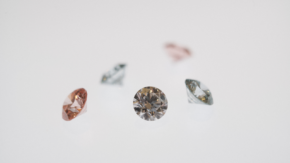| Elephant Mughal bangles from Banaras, circa late-eighteenth century, courtesy Ashok Sancheti, Pioneer Gems, New York. |
The jewelry that came out of the Mughal period in India is
perhaps some of the most celebrated and recognized, both inside and outside
that country. It is the reflection of the blend of Islamic and Hindu cultures
that merged for a period of time and left behind a legacy of art and elaborate
jewelry that is both iconic and specific to Indian culture.
“Mughal jewelry represents the finest period of jewelry
manufacture in the Indian subcontinent,” explains Rahul Kadakia, head of
jewelry, Christie’s Americas and Switzerland. “This was a time when gems were
being inscribed, carved and then set into exquisite jewels for the ruling
families. Large spinel beads, ropes of natural pearls, fine emerald beads and,
of course, Golconda diamonds were all part of the Royal treasuries.”
Mughal History
The Mughals, who were Central Asian Turks from Uzbekistan,
came to power in India in 1526. The first of the Mughal rulers, all of whom
were Muslims, was Prince Babur, descended from Ghengis Khan on his mother’s
side and Timur-i-Lang on his father’s side. Babur came to power when he
defeated the Delhi Sultan Ibrahim Shah Lodi in the First Battle of Panipat.
Babur’s rule was short lived — only until 1530, at which time leadership went
to his son Humayun, father of Akbar the Great, who is associated with the glory
of the Mughal empire.
Akbar, who reigned from 1556 to 1605, was artistically
inclined and culturally tolerant, allowing both the Islamic ways of his rule
and the Hindu ways of India to flourish side by side. His tolerant reign was
continued by his son Shah Jahan, who is best known for commissioning the Taj
Mahal, considered to be the greatest work of Mughal architecture in history.
The vast Mughal empire, which, at its peak, stretched through most of the
Indian subcontinent and into what is now Pakistan, Bangladesh, Nepal and
Afghanistan, began crumbling in the late-seventeenth century as the British
East India Company started gaining political power. The Mughal Empire came to
an end in 1857 when the Indian Army rose up against British control in the
Sepoy Rebellion and the last Mughal Emperor Bahadur Shah Zafar was arrested,
tried for treason and exiled to Rangoon in Burma. The Mughal Empire was
finished for good.
| Mughal earrings, courtesy J.&S.S. DeYoung. |
The Jewels
During the Mughal era, jewelry was an important part of the
royal court, denoting status and position. Men were adorned as equally as
women, with large jewels worn from head to toe. Jewelry created in the royal
workshops were true works of art and of the finest craftsmanship. Several
artisans — each with a specific area of expertise — worked on a single piece to
create the finished jewel. Every visible surface — front, back and sides — of
Mughal jewelry is covered in ornamentation. The Mughal style of jewelry
combined enameling and Islamic motifs of flowers, paisley and birds with the
Hindu style of goldwork and the generous use of precious stones.
“The Mughal era rulers wanted to keep the stones big so they
were generally not cut, but tumbled cabochons or beads to keep the size,” says
Ashok Sancheti, owner and president of Pioneer Gems, New York, and a collector
of Mughal jewelry. “There were a lot of table-cut diamonds in the pieces
because India had the Golconda mines. They were the only known diamond mines
until diamonds were found in Brazil in the 1700s. Emeralds came to Spain from
Colombia and then were sent to India. Rubies came from Burma, sapphires came
from Sri Lanka and Basara pearls, which are natural salt water pearls, from the
Indian Ocean.”
The enameling in Mughal jewelry is generally done in vibrant
shades of red, blue and green with white. However, Sancheti explains that the
elephant bangles (shown on the cover and opposite page), which he dates as
circa late-eighteenth to early-nineteenth century, were from a specific area.
“In the past, pink and white enameling was only done in Banaras in the Uttar
Pradesh State. In Rajasthan, where Jaipur is located, they used red, blue and
green enameling.” Banaras, also known as Varanasi, is the oldest and holiest
city in India.
Mughal jewelry has found favor with jewelry aficionados
outside of India as well. “Real, historical Mughal jewelry is intriguing,”
comments Janet Levy, principal of J. &S.S. DeYoung, who notes that American
heiress Doris Duke was an avid collector of Mughal jewelry. “It was owned by
maharajahs and maharanis and the pieces had the best of what was available at
the time. The jewelry has great table diamonds and emeralds and it is exotic
and beautiful. Mughal jewelry has huge Golconda diamonds and there is an
awareness that those diamonds were there before any others.”
Although the Mughal court jewelers are long gone, the
tradition of Mughal-inspired jewelry making continues today, primarily in
Jaipur. “It is the older generation today that is making the pieces because
they care about the art. The older pieces were solid gold and very heavy; the
newer pieces are hollow, but are sometimes filled with wax to add weight,” says
Sancheti. While weight may be one way to determine if a piece is old or new,
Sancheti notes that it is really experience that allows one to make the
distinction. “Generally, if a piece is new, it is stated that it is new,” he
says. “To find old Mughal jewelry is very hard. Some copies are made so nicely
that even experts are fooled. More and more antique pieces are going to
collectors who hold on to them as a family heirloom.”
Kadakia explains further as to why it is so difficult to
find antique Mughal jewelry. “Over the years, it has become increasingly
difficult to find Mughal jewels in their original forms as many were taken
apart and sold piece by piece,” he concludes. “This is why the appearance of
great old period Mughal jewels at auction creates record prices.”



